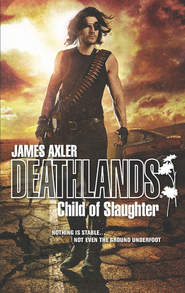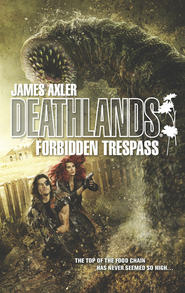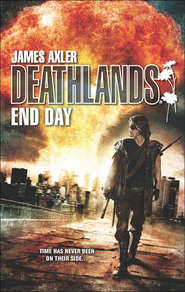По всем вопросам обращайтесь на: info@litportal.ru
(©) 2003-2025.
✖
Plague Lords
Автор
Год написания книги
2019
Настройки чтения
Размер шрифта
Высота строк
Поля
Never.
Stink was their religion. Pong was their manifesto.
According to the stories, some of the Matachìn wore bright, floral frocks over their blood-stained trousers and boots, shoulder-seam–split trophies ripped from the women they had ravaged and murdered.
According to the Fire Talkers, the Matachìn indulged in bloody and brutal ritual spectacles; they had established an extensive slave trade along the Atlantic coast of Mexico and Central America; they worked their captives to death in their agricultural fields and gaudies; and to amuse themselves during long sea voyages the pirate crews choreographed and staged slave fights to the death.
The common denominator in all the Fire Talker variations was death, unpleasant and prolonged.
Down in the ville, islanders were still gathering up everything of value, including excess stockpiles of food and fresh water. The water they couldn’t move, they dumped onto the sand. The idea was to leave the pirates nothing to eat or drink. The Nuevo-Texicans were well prepared for a long siege. They had the entire storehouse of the Yoko Maru at their disposal. The pirates had only whatever they brought along with them. Assuming the islanders could hold the ship for the duration, sooner or later problems of resupply would drive the Matachìn back to whatever hell-hole had spawned them.
The possibility did exist that the pirates had taken their fill of spoils in Browns ville, that they weren’t coming north, after all. But that wasn’t something the islanders could count on. Even as the residents crisscrossed between the ville and the Yoko Maru, explosive charges were being laid in the narrow, winding paths between the shanties. The predark Claymore mines with their payloads of steel ball bearings wouldn’t be trip-wired and armed until the enemy came into view and the last of the women and children were safely onboard the ship.
Okie raised the binocs, taking in the bow of the vessel. Surrounded by a rapt, deck-seated audience, the Fire Talker was perched on a bitt, waving his arms and talking animatedly.
Giving the droolies more to slobber about, no doubt.
The islanders’ usual practice was to securely tether the triple stupes, staking them at least three yards apart to keep them from playing hide the slime eel. When droolies mated with droolies of the opposite sex, the outcome was a foregone conclusion: more droolies. In camps elsewhere in the Deathlands, these unfortunates were not so tenderly cared for. The moment the symptoms surfaced—the slack lower jaw and vacant stare—heads were smashed in. The Nuevo-Texicans kept their little flock alive, not out of compassion or a sense of parental duty, but because the droolies were so damned amusing, even if the camp dogs failed to get the joke. Having someone around visibly more messed up than you were had another benefit, as well. It made a person feel instantly better about him or herself. “At least I’m not a droolie,” was the unspoken but ever present refrain.
Okie was struck by a sudden chill that started at the base of his spine and rippled up his back and neck, and crab-crawled over the top of his scalp. Which he found very strange, given the air temperature even with the wind was in the high eighties. As the shudder passed through him, the steel rod behind his eye probed deeper into the nerve bundle. He saw bright, dancing spots of light and once again felt the urge to spew. Worse, there was a simultaneous, uncomfortable pressure building deep down in his bowels. Had to be something he ate, he thought. Underdone rat on a stick, mebbe. Closing his eyes and gripping the rail in both hands, Okie tried to will the sensations away. He still had another couple of hours before he was relieved of the watch.
“TIME DILDO-LATOR! TIME DILDO-LATOR!” The seated droolies rocked their hips, scooting their behinds on the deck in time to the gleeful chant. “Time dildo-lator! Time dildo-lator!”
Daniel Desipio sat back and basked in their adoration. They couldn’t get enough of his backstories and technical explanations, although it was unclear if they understood a single word of the complex scientific and philosophical concepts that underlaid his narratives.
Still, the frenzied attention buoyed his spirits.
From the Yoko Maru’s bitt, Daniel surveyed the squalid little ville spread out below. Construction had started in the most weather-protected spot, in the lee of the freighter’s bow. The first cluster of single-story huts used the ship’s hull for their rear walls. Building materials had to be salvaged and ferried from the flooded ruins of Corpus, so subsequent structures shared both side and rear walls. Nothing in the ville was straight, not roofs, not doorways, not lanes, not side yards. Everything was made of accumulated scrap, unpainted or covered in peeling layers of paint. Over three decades the slapdash habitations had spread to the shore of the anchorage on the north side. The islanders had built monuments to themselves, expressing their personalities, desires, artistic senses with found materials, the restricted pallette of the rubbish heap. It could have been a village on the edge of a garbage dump in predark India or Brazil. Or a squatter camp in South Africa.
That said, the grounded container ship’s bounty had provided every ramshackle hut with its own Taiwanese knock-off Weber kettle and fancy barbecue tools, and its own plastic lawn furniture.
The Nuevo-Texicans were damn proud of their little corner of the world.
Daniel Desipio, twentieth-century freezie, had a different perspective: a shithole by any other name.
For what had to have been the thirtieth repetition in as many hours, the Fire Talker recited the story of how the Vikings acquired the time dilator, the desperate bargain they had made with the Martian hordes, and their combined exploitation of the ancient Norse Runestone Concatenation. That terrestrial-extraterrestrial plot had been frustrated by the intervention of the Iroquois Ninja princess—proud, statuesque, with raven hair and slanted black eyes, and spots of blushing rose in the centers of her buckskin-colored cheeks—and of her singing katana, and her coterie of cloud operatives that moved from one human mind to another like stops on a subway line.
As he mechanically regurgitated the pulp fiction series’ canon—something he could have done in his sleep—Daniel watched his audience for the initial, subtle signs of infection. A growing restlessness. A flushing of the face. A sensitivity to light. He visualized the viruses invading individual host cells, commandeering reproductive machinery, replicating until their sheer volume burst cell walls, then spewing forth in a torrent, hardwired to penetrate and infect new cells: an unstoppable, rising tide of the submicroscopic, leading to debilitation, agony and horrible death. All of which derived from the poison that lurked in his 137-year-old blood, and to which he was happily immune.
Whenever Daniel reflected on what had led him to his most peculiar fate, the answer was always the same: the blind pursuit of Art. It was what had animated and enthused him since the third grade when he started reading and collecting various pulp action series from second-hand bookstores. He had pored over the “Golden Age” titles until the yellowed, musty pages dropped from the bindings, absorbing the nuances of style and content. All Daniel Desipio had ever wanted to do was to write adventure books like those. Doggedly determined, he had eventually achieved his goal, but in the twenty years between his introduction to pulp and his first sale of a novel, the industry had changed. Series action fiction had become a franchise operation, produced by hamsterwheeling, faceless ghost writers; it was in effect a dead-end career.
Slaughter Realms, the house-owned pulp series he had slaved upon for seven years, had had several nameless authors and had run to well over 250 titles. All nagging questions of artistic control and continuity had been resolved by Armageddon, by more than a century of elapsed time, and by his unlikely survival.
Even before the nukecaust, individual books in the series had been forgotten, consigned to landfills and bonfires, and along with them Daniel’s contributions to the canon. He had come up with gemlike, signature exclamations for two of the main running characters, Ragnar the Viking and Nav Licim, the wilted but defiant patriarch of the celery people. In return for his devotion to his Art, Daniel Desipio received no author credit, an hourly wage well below the established national minimum and no royalties on book sales.
The turning point for him had come on March 13, 1998, when after finishing his twenty-ninth book in the series he had asked the publisher for a hundred-dollar raise and was denied. Crushed and mortified, for the first time Daniel actually considered abandoning his lifelong dream. He considered becoming a Realtor. If he had taken that career course, he would have certainly perished along with almost everyone else in the U.S. on that January day in 2001. But in a moment of pure inspiration, fueled by the depths of his outrage and despair, Daniel had decided to do something truly radical in the name of his craft, for the sake of fresh experience, of something truly unique and exciting to write about. Without a thought to the possible consequences—not that even he could have imagined them—he had thrown himself into the meat grinder of Science.
More than a century post-nukeday, the world’s values had taken a hard U-turn, and a turn for the better as far as he was concerned. The idea of bottom-rung fiction or bottom-rung consumer merchandise lost all meaning when there was nothing left for either to be compared to. Which is why the cargo of the Yoko Maru was worth fighting and dying for.
A self-guided sightseeing tour of the island’s shantytown had told Daniel what was stored in the container ship: white running shoes aplenty, wardrobes of summer fashion, circa 1999, and plastic lawn furniture. But also toothbrushes and toothpaste, toilet paper, linens, bathware and canned goods in profusion. Empty tins of pork and beans, peas, pearl onions, peaches, black olives and potted meat lay scorched in the camp middens, as well as cast-off plastic packaging from barbecue potato chips, honey-roasted peanuts, jerky sticks, cookies and candy bars. Daniel had seen bag charcoal, car batteries, spark plugs, fan belts, flatware, dishes, pots and pans, stuffed toys, cooking oil, and grooming and beauty products—bar soaps, lotions and lipsticks. There was also a variety of made-in-India, factory-loaded ammo: 9 mm Parabellum, 7.62 mm Russian and 12-gauge low-brass quail loads, among others. Apparently, the Yoko Maru held a large stockpile of predark centerfire munitions.
As he prattled away on automatic to his spellbound audience, Daniel took in the islanders’ highly organized defensive preparations, the lines of people moving on and off the ship, the self-sacking of the ville. They had a good plan. Obvious, but good. From the hard looks he was getting, they suspected him of something far more nefarious than rotting the minds of droolies—as if their suspicions mattered at this point. The fight for the island was already lost; the Nuevo-Texicans just didn’t know it…yet.
“Battle armor! Battle armor!” Daniel’s audience hollered, shattering his reverie. “Battle armor! Battle armor!”
He held up his hands for quiet. “All right, all right,” he conceded, “but this is absolutely the last time today…”
To the delight of his listeners, in highly numeric and acronymic detail Daniel went over the specifications of the Martian-made assault gear, down to the chemical composition of the metallic-plastic alloys, the thicknesses of individual body plates and the “theory” behind the nanotech circuitry they contained.
Chapter Four
After the companions had motored three miles up the road, Ryan signaled for a pull over and parlay. As the dust settled around them, Krysty, J.B., and Jak killed the motorcycles’ engines and everyone dismounted. No longer in motion, they felt the full impact of the sweltering heat.
The first words out of Ryan’s mouth were, “Check your ammo.”
The one-eyed man didn’t have to check his own. Every round he had left was loaded up, seven shots in the Steyr’s box mag, a full 15-round clip in the SIG-Sauer. While the one-eyed warrior unslung his longblaster and stood lookout, Krysty, Mildred, J.B., and Jak started their round counts. Doc, the deep creases of his prematurely aged face rimed with dirt and sweat, retired to a wide sandstone boulder at the side of the road.
Ryan watched the time traveler take a seat on the low rock and carefully lay down his sword stick. Doc dug black-powder reloading gear from his frock coat’s pockets.
More than once over the years Ryan and J.B. had tried to talk him into switching over to a weapon-chambered centerfire, but he wouldn’t hear of it. Doc was one hard-headed Victorian son of a bitch. No matter what they said, he always argued that the proof was in the chilling. And that he had never had a problem doing that with the 250-year-old LeMat. Privately, J.B. assured Ryan that someday the radblasted thing was going to explode in his hand like a frag gren.
Doc prided himself on how fast he could reload his treasured if obsolete weapon. And Ryan had to admit he was plenty fast. Since the immediate danger was miles behind them, Doc gave the chambers and both barrels a quick going over with the bore brush to scour away the worst of the burned residue. He lined up the first chamber with the hammer at halfcock and the muzzle aimed skyward, then unsnapped the pistol’s jointed rammer from its barrel clip. He measured the powder, poured it into the shallow chamber, and levered the rammer to seat a lead ball on top of it. After flicking away the little ring of excess lead the lip’s tight fit trimmed off, he put dab of grease over the bullet to lube the barrel and keep the sparks from other chambers from causing spontaneous ignition when they fired. Rotating the cylinder a full notch, he proceeded to load the next chamber, and the next, and the next, and so on. His rate of speed was as steady as his hands. After he finished the ninth chamber he securely snapped the rammer back into its clip.
The .63-caliber shotgun chamber he loaded last, using a homemade wooden ramrod to seat the aft wadding, grapeshot and front wadding. He capped all ten chambers, lowered the hammer into one of the safety notches between nipples and slipped the massive blaster back into its hand-tooled Mexican holster.
Just under five minutes had elapsed from start to finish.
In the meantime, the other companions had taken stock of what was left of their ammo. J.B. had six high-brass rounds in his M-4000’s tubular magazine. Mildred and Krysty had full cylinders in their revolvers. They had used up their speedloaders; between them they had eight loose shells. Jak had two .357 Magnum bullets left in his revolver and nothing in his pockets. Of the six, only Mildred and Krysty could swap cartridges back and forth interchangeably as they both carried .38 Specials. They evened things out with Jak, giving him a couple of bullets each. Jak could fire their .38s in his .357, but they couldn’t shoot his cartridges because of the Magnum’s longer case.
J.B. was the first to dig into one of the looted backpacks.
“Well, lookee here!” he exclaimed, holding up a plastic-wrapped, gold-colored brick for all to see.
Taped to the outside of the kilo of C-4 was a sealed blister pack that contained blasting caps and electronic trigger, radio detonator and two sets of lithium batteries—one to set off the cap, one for the remote detonating device. As a backup, there was also a coil of thick, white blasting cord.
Ryan and the other companions quickly dumped out the contents of the other five packs. There was no ammo. No food. No water. Just predark plastic explosive and detonators. There was enough plastique piled in the middle of the road to turn a square city block into rubble.
“Well, we know the stuff still works,” Mildred said.
“Stickies found that out the hard way,” Krysty said. J.B. turned the brick over in his hand and read the text on the packaging. “Check the address,” he said, showing Ryan what was written.
“What is the significance of the label?” Doc asked, staring down at a brick he had picked up.
“Back in the day,” Ryan explained, “when J.B. and me were running with Trader, there was a rumor going around about a predark industrial plant in western New Mex, where the government used to turn high ex into C-4. Supposedly the finished product was stored in deep, blastproof bunkers in the desert. Looks like our dead scroungers stumbled on the motherload.”
“Worth big jack,” Jak said appreciatively, toeing the pile with a boot tip.
“To the right buyer,” Mildred said. “The trouble is, we’re a long way from the nearest baron.”











